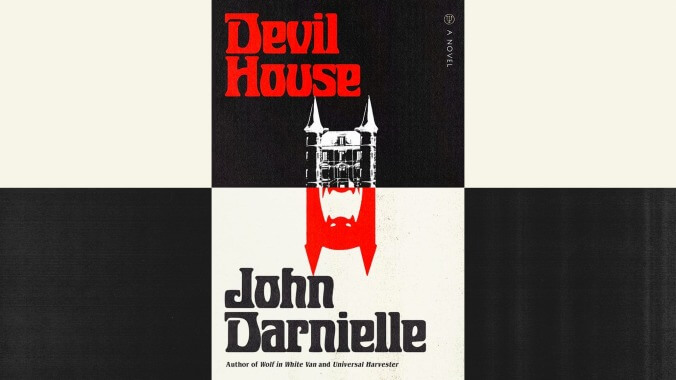John Darnielle untangles the knotty ethics of true crime in the fictional Devil House
The third novel from the Mountain Goats frontman centers around a true crime writer and a pair of grisly murders

Gage Chandler isn’t like the other true crime writers. That’s impressed upon readers early in The Mountain Goats frontman John Darnielle’s third novel, Devil House. “I try to honor the dead in my books,” Chandler says. “It’s one of the things, I hope, that sets me apart a little from my partners in true crime.”
For much of the novel, Chandler is the sole occupant of the Devil House in Milpitas, California; he moves there in order to write about a pair of murders that took place in the house in 1986. Before it was his home or the scene of a crime, it was a soda shop and then a porn store. The victims were the property owner and a prospective buyer; the assumed perpetrators, a group of teenagers who had made the space a second (or in one case, only) home. When the murders occurred, at the height of the satanic panic, the state of the house—animal bones and broken glass strewn everywhere, disturbing imagery covering the walls—led the townspeople to assume it was the work of a cult.
As Chandler settles into his new home and town, the forthcoming plot beats —as is often the case with crime stories, true and otherwise—feel clear: slowly uncovered evidence, a few red herrings, brushes with danger.
Then Darnielle jumps forward a year, when Chandler has come upon information that contradicts his original understanding of the murders.
I have combed every inch of the ground where something dreadful happened some years back, and it is time now for me to tell the story I was sent here to tell. I don’t want to do this, and I’m not going to do this.
Here is where Devil House is cleft wide open and a brilliant novel tumbles out. After the first section, detailing Chandler’s project, come alternating sections about the Devil House murders and one of Chandler’s previous books about another case, The White Witch murders.
Ingrained in each part is a question about the nature of true crime and whether it’s possible to write it ethically and with real compassion for the victims. “At its best, true crime feels much like biography—compelling, revealing, intimate, and, in the last analysis, inexcusable,” B.D. McClay writes in her essay “Blood Sport.” Darnielle evokes this feeling throughout, particularly in The White Witch passages.
The first of these sections is written in the second-person with a tight focus on The White Witch, Diane Crane, a teacher who kills two students when they break into her home. Darnielle skillfully navigates the difficult point of view, pulling the reader ever tighter into the narrative. He sprinkles the first-person throughout as a reminder that it’s Chandler who’s telling the story, and each hits like an unexpected creak, as if I’d been caught watching something I shouldn’t have been.
This sense is multiplied in the second White Witch section, in which Chandler reads a letter from Jana Perez, the mother of one of the boys who Crane killed. Perez feels that Chandler did exactly what he hoped to avoid: He flattened her son, making him the character Chandler needed instead of reflecting who he really was. Perez shares her son’s life story, with special attention to the pain caused by his abusive father and her son’s kindness and perseverance. The most heartbreaking parts come when Perez defends her desire to correct the record: “The people were real,” she writes to Chandler. It continues:
I get it, though, you probably think I don’t but I do. A story has to be about something, it’s not just about the people in it and everything else that ever happened to them. See? I understand.
The narrative impetus of true crime is so powerful that even a grieving mother feels compelled to empathize with the writer who simplified her son’s life story.
The sections set in the Devil House are comparatively conventional, but no less gripping. Chandler focuses on Derrick Hall, the most straitlaced of the would-be murderers, and whose one-time job at the porn shop sets the wheels in motion. In these passages, Darnielle vividly captures the boredom and possibility of one’s waning teenage years, as each choice the future murderers makes marches them nearer and nearer to the creation of their bizarro hell world.
Unfortunately, the novel’s interlude nearly derails the book. The telling of a Welsh legend about King Gorbonianus, it’s written in a dreadful mock medieval syntax—e.g., “And some do say, that husband-men from the stables, did also come, for that they loved their queen”—and typeset in an even worse font. The combination brings the section to the brink of unreadable. Its connection to the narrative is tenuous, it illuminates very little, and perhaps the best evidence that the rest of Devil House is spectacular is that even this section can’t ruin it.
As for Chandler and his sections, which begin and end the novel, Darnielle impressively dramatizes the writing of a true crime book and the massively deleterious effect the process has on a person genuinely concerned with the ethics of what they’re doing. “Writers are terrible people,” Chandler tells an old friend toward the end of the book. “Everything’s just material to us.” In the hypnotic world of Devil House, this Janet Malcolm-Nora Ephron mash-up feels less like pablum than it does a guilty plea.
“What happens when somebody tells a story that has real people in it?” Chandler asks. “What happens to the story; what happens to the teller; what happens to the people?” Darnielle renders this dilemma—and the bad-taste curiosity that compels people to read and write true crime despite reservations—with such depth and clarity that it feels like he’s somehow culpable too. That’s good fiction writing.
Author photo: Lalitree Darnielle